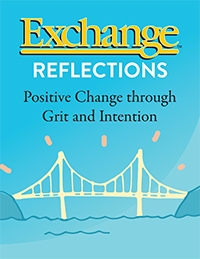ExchangeEveryDay Past Issues
 << Previous Issue
| View Past Issues | | Next Issue >>
<< Previous Issue
| View Past Issues | | Next Issue >> -Mark Twain
In an article that forms the basis for a popular Exchange Reflections, “Affirm the Child, Not the Behavior,” Daniel Gartrell provides an example of how to increase positive behavior by affirming the child, not their challenging behavior:
“Take the case of 42-month old Gabriel, who crowds a smaller preschooler off an adult’s lap in order to get a favorite book read. Gabriel causes a conflict here to gain the privilege of closeness to the provider and control of which book is read next. Does the adult punish Gabriel for this mistaken behavior? Hopefully not, as disciplining Gabriel will only aggravate unmet needs for acceptance and belonging. Does the adult read Gabriel’s book as though nothing has happened? Hopefully not, as rewarding Gabriel will only reinforce the child’s (and perhaps the adult’s) confusion of a need for attention with a need for affirmation.
Instead, the early childhood professional knows that the kid only has 42 months of experience and an early-developing brain. S/he uses guidance instead of conventional discipline to affirm and teach what the child needs to learn for healthy emotional and social development…
Illustration:
Ignoring a very crowded lap, the educator whispers in Gabriel’s ear:
- First an affirmation like, ‘Gabriel, you really like that funny book.’
- Then a direction, ‘We will read it right after Robin’s book. Gabriel, you can stay by my side and read with us or look at your book until we are done.’
- Finally, another affirmation: ‘Robin’s book will be fun, and you and your fun book are next for a turn.’”
 May not be combined with any other offer. Not valid on bulk purchase discounts. |
ExchangeEveryDay
Delivered five days a week containing news, success stories, solutions, trend reports, and much more.
What is ExchangeEveryDay?
ExchangeEveryDay is the official electronic newsletter for Exchange Press. It is delivered five days a week containing news stories, success stories, solutions, trend reports, and much more.


Comments (6)
Displaying 5 of 6 Comments [ View all ]Dimensions
Lincoln, NE, United States
Thank you all for sharing your thoughts! Your perspectives all made me think more on the topic.
-Tiffany at Exchange
United States
I totally agree with using guidance instead of conventional discipline to teach the child. Providing positive affirmation and direction sound right.
My questions are, would the situation also be a great opportunity:
- to positively guide and teach (not discipline) Gabriel what an appropriate/acceptable behavior would look like?
- for Gabriel to learn societal acceptable (and not acceptable) behavior as part of his healthy social and brain development to add to his 42 months of experience?
Center for the Study of Biracial Children
Denver, Colorado, United States
This comment is for the post about "Thinking for oneself", and not the discipline article.
Not only is it OK to disagree with the content in books and articles about current ECE topics, it is a central part of the responsibility of all those who work with young children to critically examine anything they read! I rarely agree with everything I read in an Exchange article or book; I disagree with some more than others.
I use two frameworks to critically analyze content: historical perspective, and postmodernism. It is very important to know that the vast majority of ideas and concepts being recommended today are actually an important part of our history: Dewey's progressive education; Piaget's view of development and learning; the free school movement of the 1960-90s. In fact, the Reggio ECE model profiled in the recent Exchange Magazine is indebted to both Dewey and Piaget, and also Froebel.
Polly Greenberg, a past editor of Young Children, always told me that we must be aware of our past; we can never forget it!
As to post-modernism, the concepts of deconstruction and reconstruction work very well, so long as we understand that deconstruction does not mean to "throw out the baby with the bathwater". Reconstruction means taking from what worked before and adding it to new ideas and concepts.
it is critical each of us carefully and critically examine the new ideas and "movements" to make sure they are in fact best for all of our children, families, staff, and communities.
Woodland Academy
Philadelphia , PA, United States
That is great, acknowledging the child’s requests ensuring that the child is seen and heard.????????????
United States
I totally agree with using guidance instead of conventional discipline to teach the child. Providing positive affirmation and direction sound right.
My questions are, would the situation also be a great opportunity:
- to positively guide and teach (not discipline) Gabriel what an appropriate/acceptable behavior would look like?
- for Gabriel to learn societal acceptable (and not acceptable) behavior as part of his healthy social and brain development to add to his 42 months of experience?
Post a Comment